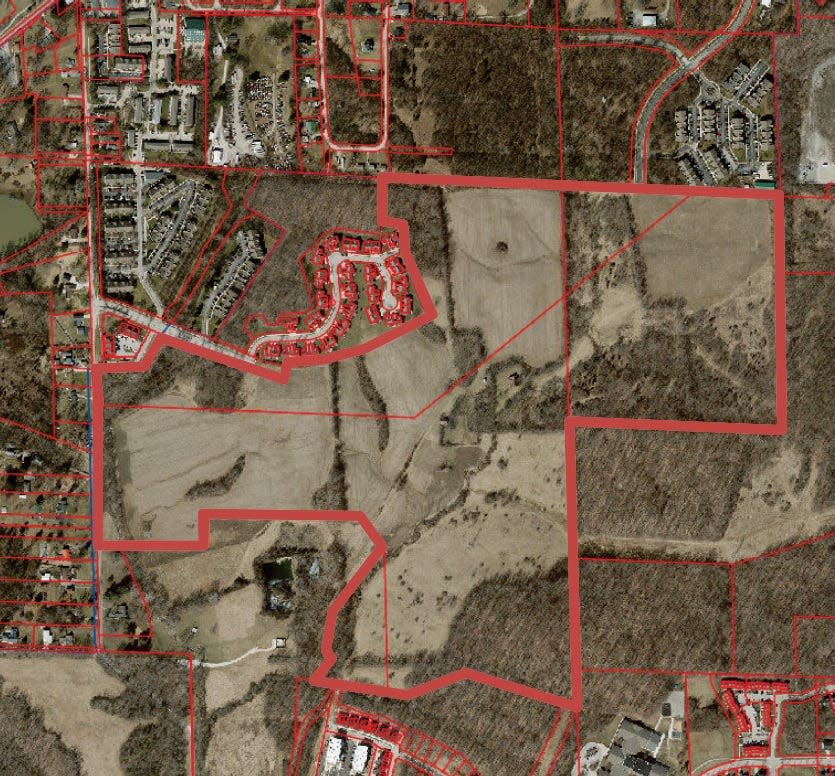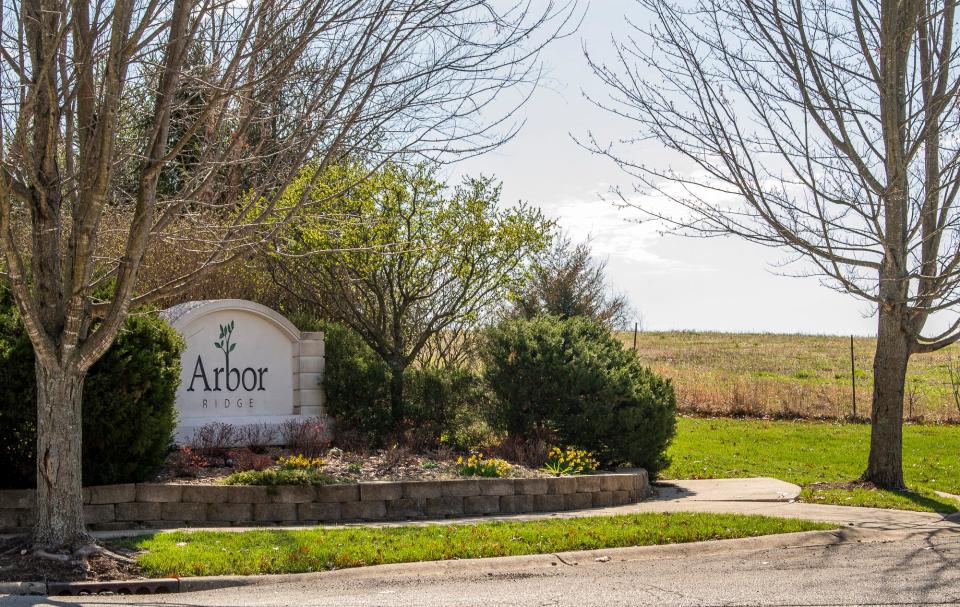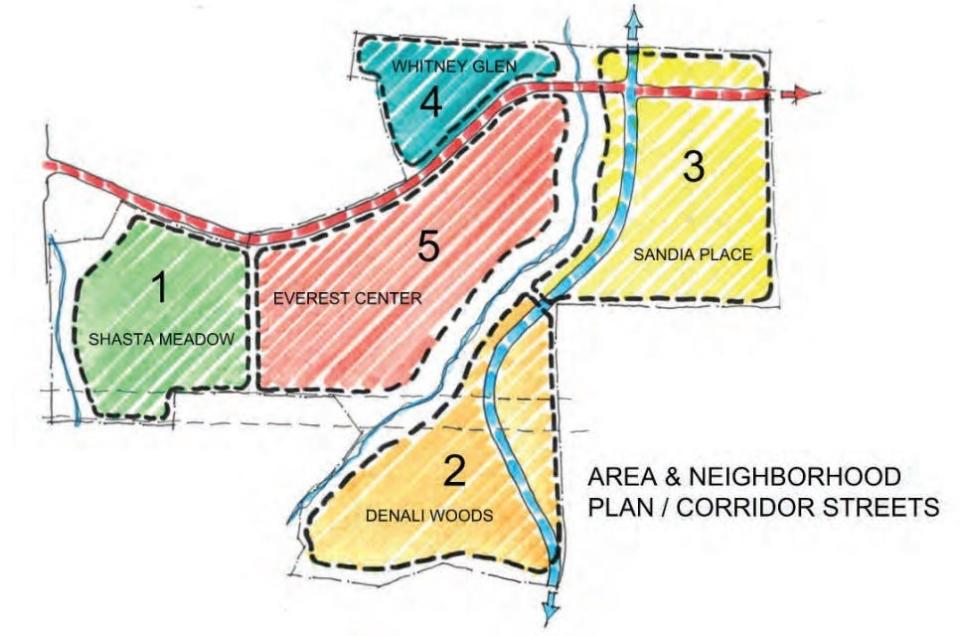4,250-unit residential development in southwest Bloomington takes step forward

A residential development that would bring thousands of units to southwestern Bloomington, which has raised neighbor concerns about matters including traffic, flooding and scale, is headed to the city council.
The Bloomington Plan Commission last week voted nearly unanimously to forward the proposal to the Bloomington City Council with a positive recommendation.
Sudbury Development Partners envisions up to 4,250 housing units — from single-family homes to 12-story apartment buildings — with some of the five planned neighborhoods including construction of non-residential facilities including offices, a library and restaurants.
Sudbury is a limited liability company formed by Muncie-based The Ridge Group Development and Carmel-based Sullivan Development. The developers said they expect the 139-acre property east of South Weimer Road and southwest of Catalent’s Bloomington campus to be developed over the next decade, though a local planning official last year called that timeline “aggressive.”

The development partners, who bought the property about a year ago for $13.2 million, have said they expect to build only about 10% of the housing units, with other developers tackling other portions.
The developers initially proposed building up to 6,000 housing units, but have pared back the proposal based on feedback from community members and local planners.
At least 15% of the units will have to be affordable, meaning for people who earn less than 120% of the area median income. The U.S. Department of Housing and Urban Development set last year’s AMI for Bloomington at $94,700. At that level, the affordable units would go to families earning no more than $113,640.
The plan commission forwarded the development proposal last week to the council after a 4.5-hour special meeting that had only the Sudbury development on the agenda and included nearly an hour of public comments.
Plan commission members emphasized they were discussing only overall building guidelines for the entire acreage, but were not approving the construction of specific buildings. The members said they and the public would get dozens more opportunities to provide input on what, specifically, gets built where.
“Our work has barely begun,” plan commission President Brad Wisler said.

Plan commissioners generally praised the developers for preparing to bring much-needed housing to the area, though they also said they needed to consider the development’s impact on water and sewer infrastructure and streets, as well as how the planned buildings would fit into the existing neighborhoods and into the city as a whole.
Commission Vice President Jillian Kinzie said she believed the pared-back proposal “balances denser development and environmental protections.”
The document the commission forwarded to the city council includes 10 conditions that essentially would function as guardrails on what developers can build and what they must do before they can build. For example, the conditions require a karst study and improvements to water, sewer, drainage and transportation infrastructure. The conditions also place a cap on building square footage and height.
Nonetheless, some neighbors expressed concerns about living in the literal shadow of monolithic high-rises, with one saying the idea of thousands of pairs of eyes looking from a high-rise into his home freaks him out, while another said he would fight a proposal of 4,500 housing units until the day he dies.
How tall would buildings in Bloomington's Sudbury development be?

The sizes and heights of buildings in the five planned neighborhoods — Shasta Meadow, Denali Woods, Sandia Place, Whitney Glen and Everest Center — would differ. Developers plan to begin with Shasta Meadow, on the west side, which would include single-family homes, duplexes and some multi-family units. Construction in that neighborhood would take place from 2025 to 2029. The neighborhood would have about 550 residential units. The last neighborhood, Everest Center, east of Shasta Meadows, would be the most dense — 1,700 residential units — and include some of the tallest structures. Construction on that neighborhood is tentatively scheduled from 2027 to 2034.
Plans call for developers to build smaller buildings next to existing developments. Taller buildings would require higher floors to have a smaller footprint than the first few floors so that the top floors cannot be seen by people who are walking next to the building. The edges of some of the higher floors would have to be 10 feet from the edges of the lower floors, akin to a stepped pyramid. That approach allows the developer to build higher but makes the building feel “less oppressive,” said Jackie Scanlan, the planning department’s interim director.
The approach can be observed on many downtown Bloomington buildings, including the Graduate Hotel, on Kirkwood Avenue, and the Annex apartments at Grant and Third streets.
The tallest of the buildings in the new development — in Everest Center and, to its east, Sandia Place — could reach about 134 feet, which would be 12 stories. Developers would be allowed that height only three times and would be able to reach it only if they met affordable housing and other incentives. The 12-story buildings would require step backs on each floor above the sixth.
While one neighbor said the development’s density would exceed Chicago’s, and another worried the development would result in Indianapolis-like "projects" that would push up the local murder rate, the developers said the tallest of the structures in the neighborhood won’t be anywhere close to the tallest building in Indianapolis, West Lafayette or even Bloomington.
The tallest building in Bloomington is Eigenmann Hall, on the Indiana University campus. The building is 147 feet tall, though the main roof rises to 130 feet. The tallest building in West Lafayette is Rise at Chauncey, a residential structure that is 176 feet high. The tallest building in Indianapolis is the Salesforce Tower, at 701 feet. The tallest building in Chicago is the 110-story Willis Tower, which rises to 1,451 feet, or about 11 times higher than the tallest building planned in the Sudbury development.
At 134 feet, the development’s tallest building would be about as tall as Eigenmann. However, Angela Parker, an attorney with Bloomington law firm Carmin Parker and a representative of the developers, said via email that comparing a modern apartment building with a university dormitory from the 1960s is inappropriate, in part because the older buildings lacked design standards, such as step backs.
She said buildings in the Sudbury development would be similar in density to other recently constructed apartment buildings in downtown Bloomington and established areas northeast of downtown.
Neighbors concerned about traffic; supporters cite need for housing
Some plan commission members praised neighbors for their thoughtful feedback and the developers for responding to the concerns.
Of the nearly 20 people who provided public comment, more than half opposed the project or aspects of it. Some of the opponents said they supported the construction of more housing, but questioned whether the Sudbury project’s scale and density were appropriate for the area or Bloomington in general. Many also worried about the impact on flooding and traffic, especially given that sections of nearby Weimer Road cannot handle existing traffic.
“The traffic at both ends of Weimer is already a problem … and it’s just going to get worse,” said Ted Frick, who lives at 1812 S. Weimer Road.
City officials and the developers said they expect the project to reinforce the need for and to accelerate construction of road and intersection improvements in the area.
As in previous density discussions in the city and county, the project's opponents mostly were older homeowners, while supporters were largely younger or represented local organizations such as Habitat for Humanity, the United Way and the chamber of commerce.
Representatives of local employers have long said the lack of housing, especially affordable housing, is hampering economic growth — though some local officials have countered the housing crisis is, at least in part, a low wage crisis.
Other government officials have said the lack of housing in Monroe County is pushing people to live elsewhere, which means governmental units in Monroe County are losing out on tax dollars that could fund, among other things, needed infrastructure improvements.
Supporters of the Sudbury project said it would provide much-needed housing in an area that is ideal for development.
“We desperately need more projects like this one,” said Greg Alexander, a Bloomington resident, frequent guest at public meetings and member of the Bloomington Traffic Commission.
Alexander pointed out the development area is about a 15-minute bike ride from the county courthouse, which means people could easily walk or bike to downtown Bloomington, provided the city builds the proper infrastructure.
“This is not out in the boonies,” Alexander said. “It needs to be developed.”
Frick, who raised concerns about traffic, flooding and other issues, said after the meeting via email that public discussions and reports he has read have somewhat allayed his initial fears.
“I still don't know exactly how the issues of storm-water run-off and traffic congestion will eventually be addressed,” he said. “But I have hope and now more confidence that the city will be carefully monitoring the development process.
“I am hopeful that this huge project will move forward with reasonable checks and balances built in, so we end up with a neighborhood that we still want to live in,” Frick said.
Scanlan said she expects the Bloomington City Council to take up the matter as early as next month.
Boris Ladwig can be reached at bladwig@therepublic.com.
This article originally appeared on The Herald-Times: 4,250-unit Bloomington housing development may have 12-story buildings

